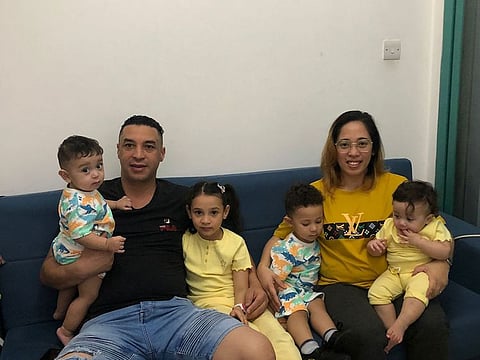‘My twins had to have blood transfusions in the womb’: Filipino expat in UAE
Rare blood disease meant her antibodies were fighting their red blood cells

When Filipino expat in Dubai, Bernadette Panganivan gave birth to her second child two years ago, she was shocked at the frail, pale child. He was born at 35 weeks of gestation, but being pre-term, said doctors, could not account for the severe shortage of red blood cells.
As her son got a blood transfusion and his vitals improved, the doctors diagnosed the condition as Rh disease, or Rhesus disease.
Dr Mohamed Khalafallah, Acting Medical Director and Consultant – Obstetrics and Gynaecology at Bareen International Hospital, explains: “Blood types and factors are determined by genetics. Everyone has a blood type (O, A, B, or AB), and Rh factor (positive or negative). The Rh factor is a protein covering the red blood cells. Babies can have either parent or a combination of both blood types and Rh factors. If the mother's Rh factor is negative and the baby's Rh factor is positive, the mother's immune system can produce Rh antibodies and attack the baby's red blood cells as foreign substances. Babies can develop jaundice, heart failure and organ enlargement.”
In Bernadette’s case, doctors while recognising that her blood and her baby’s was incompatible, were stumped; both she and her child were O positive and RH positive. “Rhesus disease should not have happened,” says Bernadette.
As she got over the trauma of the pregnancy, a year later Bernadette was pregnant once again – this time with twins. “I was so surprised,” she laughs, “I was on [birth control] pills at that time and I still got pregnant.”
From the get go, the pregnancy was deemed high risk and doctors monitored her situation closely. “I needed to do scans every two to three days to monitor their blood,” she recalls.
How is Rhesus disease diagnosed?
“Every pregnant woman undergoes a blood test early during their pregnancy to identify the production of antibodies. If the test indicates the presence of antibodies, then they must undergo other diagnostic procedures,” says Dr Danu Chandradas, Specialist Gynecologist at Aster Hospital in Sharjah. “Blood type incompatibility becomes a problem when the mother's and baby's blood mix during pregnancy. An ultrasound is done to evaluate blood flow in the baby's brain, which will help in determining early anemia. It would also help in detecting organ enlargement or fluid build-up. “Mothers with blood compatibility issues have to be regularly screened to test their antibody levels to determine the baby's risk of anemia,” he adds.
Even as the twins – a boy and a girl – grew in the womb, there were signs of anemia; the haemoglobin levels were plummeting. “They had to be given blood transfusions in the 28th week of gestation,” she recalls.
The procedure requires great skill. It is done, explains Dr Danu Chandradas, Specialist Gynecologist at Aster Hospital, by placing a needle that travels through the mother's uterus into the umbilical cord vein or the baby's abdominal cavity to replenish red blood cells. “This prevents the risk of developing anemia in the baby from progressing into hydrops [fetalis – a condition in which fluid building up in a baby’s tissues and organs causes extensive swelling]. Intrauterine transfusions may need to be repeated, and the baby may require another transfusion immediately after birth,” he adds.
What is hydrops?
Hydrops fetalis is severe swelling (edema) in an unborn baby or a newborn baby. It is a life-threatening problem. Source: Stanford Children’s Health, US
Doctors also suggested the babies be birthed – though a C-section – in their 33rd week of gestation. “RH disease treatment depends on the severity of the illness,” explains Dr Khalafallah. “One method is fetal intrauterine transfusion of red blood cells. The second method is early delivery if the baby has developed any complications.”
There was one last hurdle to the births, however; a lack of compatible blood in the bank. “At 33 weeks, we had decided already to get them out, but there was no compatible blood in the bank. They couldn’t operate on me until we had plenty of blood – O positive and RH positive - for the babies,” says Bernadette.
Finally, the twins were born in week 35 – and immediately ushered into the neonatal intensive care unit, where they were hooked up to blood bags. “Thankfully, all my children fight well – they win the battle,” laughs Bernadette.
A year on, the twins have been steadily growing, meeting their milestones and gurgling their way to good health. “They can at age one walk more than three steps without help,” says the proud mum of four.
Have a story to share? Write to us at parenting@gulfnews.com
Sign up for the Daily Briefing
Get the latest news and updates straight to your inbox



